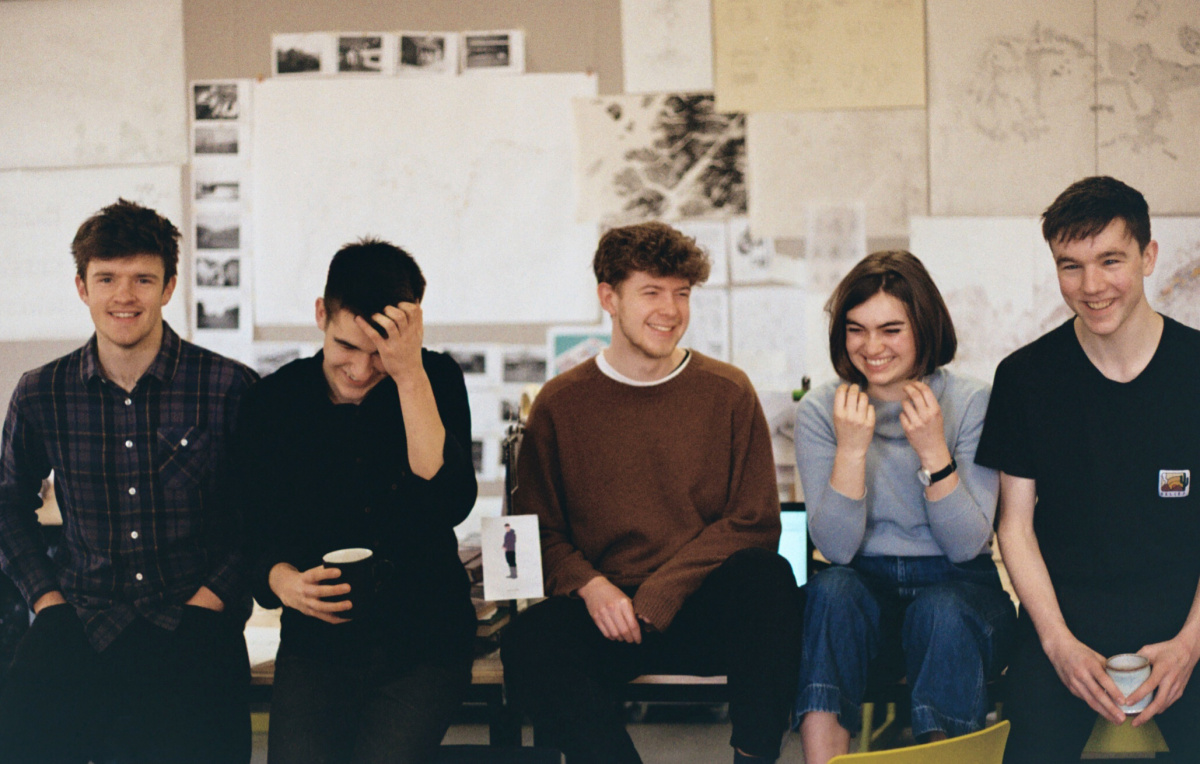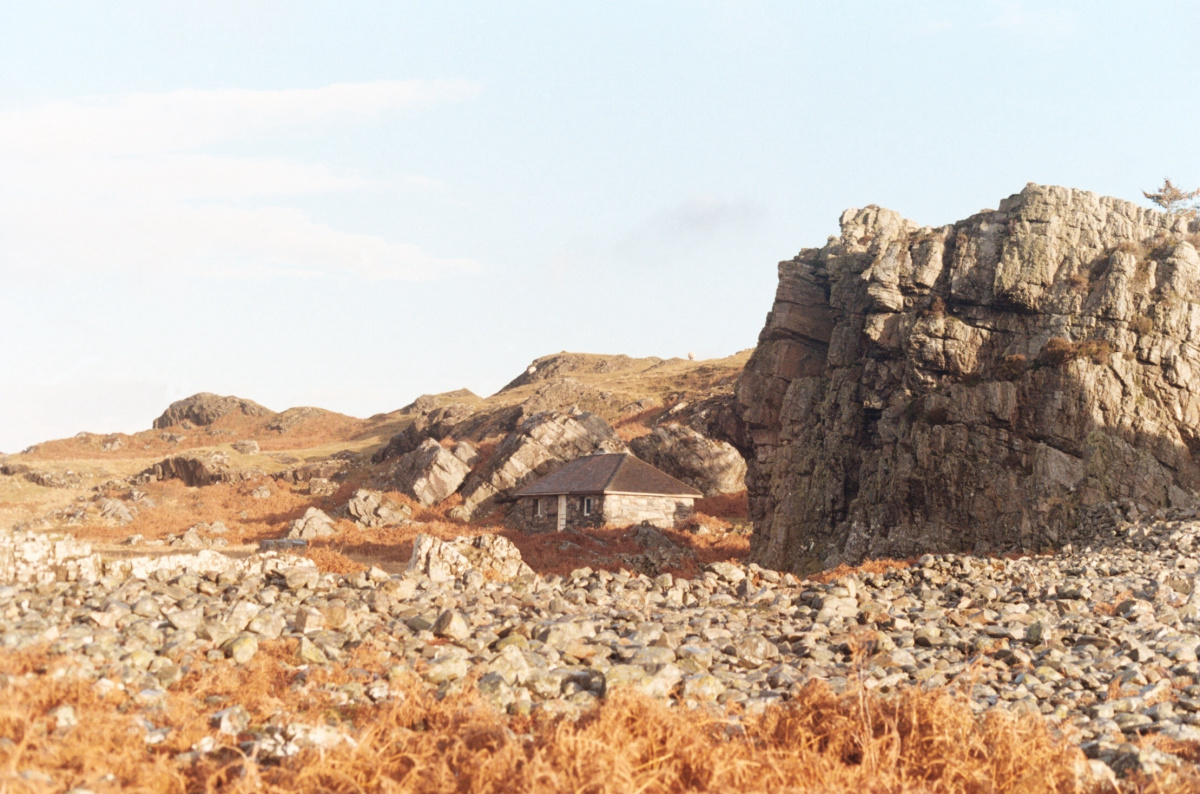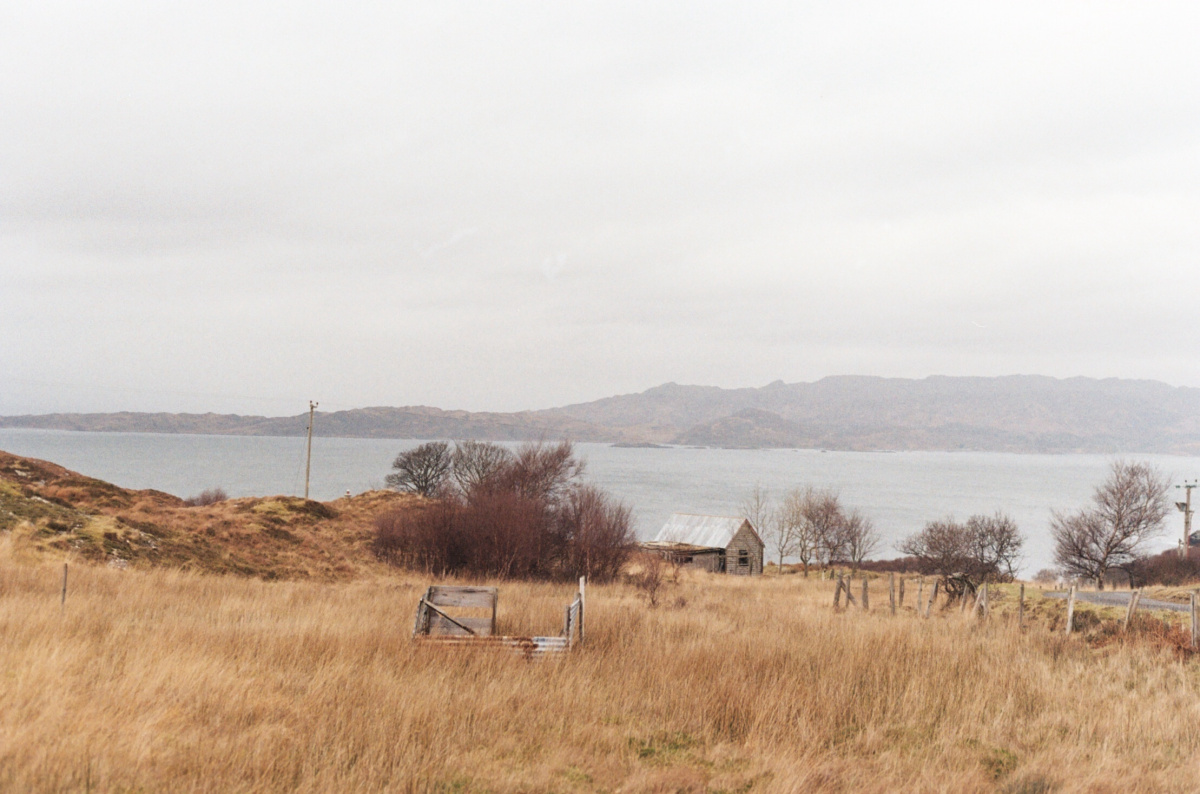Specifically Shared
Crumble

A Crumble conversation with Jamie, Rose, Joshua, Cameron and Cameron; authors of ‘s dòcha: Suggested Architectures for Glenuig.
As part of the fourth-year open studio at the University of Edinburgh, five students worked on a group proposal for the coastal community of Glenuig. The outcome is five speculative projects, each with an independent specificity that draws from a collective ethos. The proposal balances personal investigations, speculative development theories and a central socially conscious agenda, all in the relative nakedness of an intensely rural context. We met in a zoom room to discuss the process and lessons of the project.

Glenuig 1
* 8ish pm on a Wednesday evening *
* small talk and pleasantries conclude *
Felix: To start with, let’s take a look at the list of pledges from your initial group manifesto.
- To learn Gaelic.
- To have a local awareness and a sustainable consciousness with regards to our use of materials.
- To build a machine.
- For local residents to inform the design process to understand the unique nature and culture of Glenuig
- To exhibit for the community of Glenuig
- To build something at 1:1
- To share
- To care to look out for birds and to know their names
- To go for a swim in Samalaman Bay
How far have you got through this list?
Cam Y: We went for a swim at Glenuig! I ran down the road in my boxers. Pretty isolated. Pretty cold.
Rose: I didn’t…it was January.
Cam A: When we started out, the pledges were quite idealistic. It was an idealistic list. It’s easy to get stuck in the grind of university deadlines and drawings. I think this was something we felt we could put together that was somehow a bit disconnected from that. Its still related to Glenuig, but it was something to keep you engaged.
Cam Y: It brought a lot of character to the project, it injected some personality from the outset.
Rose: We definitely got lots of bird names down!
Josh: I did, yeah! and we are definitely going to aim for the exhibit in Glenuig, to tick that one off.
* general contented murmurs*
Felix: Let’s talk about the context. A rural context is not a typical setting for student work. What brought you to this common desire to work with a rural condition?
Cam A: I think most of our student projects were urban based up until s’dòcha. This project is set in an extremely rural condition. Being able to work in such a stunning landscape is such a lovely opportunity. I think that was a real lure.
Josh: I think working in a rural setting allowed us to be very intimate and really study context in its full depth.
Rose: The context is less obvious, you can’t relate to buildings, you have to be more in touch with the project, its site, the history, the geography.
Ben: Jamie you’re from Glenuig, did you find you were quite selective of who you invited to Glenuig as you were ultimately designing something for your home?
Jamie: Yeah, I think I was. I guess that I looked for folk who I hoped would approach it sensitively. I don’t quite know what my neighbours might think, but I was quietly pleased that everyone got that sensitivity.
Cam Y: It was quite intense at the start. Trying to be very sensitive to Jamie’s home with different ideas; it was quite a challenge to come to a consensus. It took a lot of discussion.
Rose: Basically, for two weeks at the start we did no work, we just chatted. We talked a lot. Even though our projects split eventually, we managed to retain a common ethos.
Cam Y: The framework we came to, was inspired by the Hejduk’s Victims projects. It allowed us to go of into lockdown and work independently. It gave us a freedom to be ambitious within a sensitive framework.
Jamie: I thought it was really liberating in a way, and it permitted diversity.
Rose: It’s quite fun to play the game of matching the project to the person. For me it’s obvious. I think we have all gone for something that is quite true to ourselves.
Ben: I think that’s a visible strength of the group, that none of these projects have to stand on their own, but they all can. I think it allows them to be bravely personal and very specific.
Jamie: Yeah, I guess mine comes from a very personal place. The idea for the project has been in the background for a while. I’m glad that the different ideas sit so well alongside each other.
* internet rumbling from an unknown source*
Rose: Sorry I missed the question. I had people shouting at me in the background, are we touching on the specific moments of each project?
Ben: Yeah, I think a real strength of your projects is the lack of multifunctional or un-programmed space. There is specificity to each programme which makes them really legible. Perhaps you could expand on how you each got your programmes?
Rose: I was really interested in fab-labs and giving autonomy to a community through an act of making. Digitally we are very connected but access to resources in workshops or places to make something, well there is a large inequality in that. I wanted to do something with making and providing a facility for people to do.
Cam A: I was always quite interested in art in relation to a community, so I landed on the idea of an artist’s residency. My coastal site provided an interaction between the rocks and topography and provided something to engage with the design. I found it very challenging at times due to the lack of restrictions. On an urban scale there are more specifics, e.g. another building blocking light, but here, and this goes for all of us, there were virtually endless opportunities.
Josh: I think, for mine, I didn’t have any concrete ideas before I went there. After visiting, I wanted the project to focus on extracting place objectively and for me, it was all about the natural things; setting up a programme to look at Glenuig and discover place through observation. Some of the birds are unique, specific to Glenuig; every time I visited, there was a clear night for seeing the stars; and, obviously there is the presence of the sea. These are the things that stood out. I wanted to frame their contribution to the character of Glenuig.
Cam Y: My houses were more about trying to understand place and trying to find the everyday of Glenuig. The house is the place you understand the most, you have the best idea of how you move through it. I wanted to play with this and turn it around to be playful with a deliberate subversion from the standard sequentiality of a house. A slowness was what I also wanted to get across, the essence of my architecture was not necessarily programme but the everyday use.
* There is a short caesura as the zoom room subconsciously considers slowness*

Glenuig 2
Ben: Shall we tackle the inevitable covid question? This is a quote from your manifesto
“It is our intention for these buildings to be flexible in their use but together they promote a community centrality and encourage face to face interaction. These architecturally defined complexes, ‘islands’ or condensed streets evoke a renewed sense of place. The buildings will have varying degrees of connection to each other but they react dialectically to one another. They are not scattered fragments but bound as a whole. Connection is an important term in the context of our project.’’
Perhaps you could discuss how the break away from studio affected things.
* another brief pause*
Cam A: I think in some ways it came as a blessing in disguise. I think it was frustrating when the kinds of dialogue we had in studio around a central table were taken away. That is what we did a lot of, chatting, calling out each other’s blind spots.
Cam Y: We all got a lot from seeing one another’s work, like seeing Rose’s painting on the wall or your (Rose’s) ability to model make in a free-way. I think I lost a certain creativity from not seeing that each day and being away from other people’s ideas. It was positive because you could push forwards with your own agenda but also there was a sadness in not seeing amazing drawings on the wall each day.
Rose: I came back to my parent’s house when it happened. Such different contexts create a different atmosphere for design and whilst the ideas stayed the same I certainly did fall out of love with the project for a while. I think our playpark book was the only part of the project that wouldn’t have happened without covid, and that was quite cool.
* a shared smile spreads across the zoom room; fond memories of play apparatus*
Jamie: When it all did happen, we were ok as we had a basis. Personally, it became all about drawing which I found quite helpful. I just went into tunnel vision with a new focus. I kind of enjoyed this, it was quite simple in a way. All quite hard however.
Cam A: In the last couple weeks, it certainly did feel like an individual project. I think this is both the beauty and the curse of the Hejduk methodology. It allowed freedom of doing your own independent free investigation whilst also being part of a collective.
Rose: Thinking about the playpark book, we were designing playparks whilst playparks shut, there was something slightly odd, especially as kids still needed to play. Interaction and making together was something lost and lockdown perhaps made these things more utopian, almost in search of the world we were missing.
Cam Y: There was definitely an irony to the playparks as not only were they shut but the youngest person in Glenuig was about 40. It was a bold statement to put a playpark there.
Jamie: There is now a baby in Glenuig!
Group: Aww, horay!
Cam A: They are going to have a lit park to play in!
Rose: We need to build it and then they will!
28.07.2020